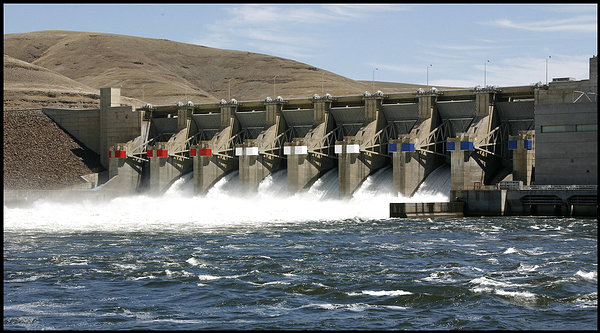forum
library
tutorial
contact

Dam Operators Work with Scientists to Determine
the Best Way to Help Young Salmon Pass Through the Dams
by Amanda Arden
KOIN 6 News, April 17, 2023
|
the film forum library tutorial contact |

|
Dam Operators Work with Scientists to Determine
by Amanda Arden
|
 PORTLAND, Ore. -- In an effort to make the journey easier for young salmon and steelhead fish traveling to the Pacific Ocean, the U.S. Army Corps of Engineers began spilling hundreds of thousands of gallons of water over spillways at dams on the Columbia and Snake rivers.
PORTLAND, Ore. -- In an effort to make the journey easier for young salmon and steelhead fish traveling to the Pacific Ocean, the U.S. Army Corps of Engineers began spilling hundreds of thousands of gallons of water over spillways at dams on the Columbia and Snake rivers.
This annual spring spill has taken place since the mid-1990s and helps decrease the time it takes juvenile salmon and steelhead to move through the system of dams to get to the Pacific Ocean. It gives them a way to travel the rivers without passing through a turbine -- the part of the dam that spins to generate electricity.
On the lower Columbia River, the spill began on April 10 and on the lower Snake River it began April 3.
"For the past several years, we have worked with our regional partners to operate the dams in a manner that is as beneficial as possible for fish including out-migrating juvenile salmonids, returning adult salmon, steelhead and lamprey as well as resident fish" said Tim Dykstra, the U.S. Army Corps of Engineers' Northwestern Division Fish Policy lead.
He said this can be challenging as dam operators balance flood risk management, hydropower production, navigation and fish management goals.
"Very high volumes of spill that benefit juvenile fish can sometimes disorient and hamper adult fish migrating upstream," Dykstra said.
The Bonneville Power Administration has said spilling water over dams rather than passing it through turbines generates less electricity and potentially reduces BPA's revenues. Sometimes, when there's less electricity generated, BPA said it may need to purchase additional power to meet its needs.
"We have a certain amount of water available and whatever water we put over the spillway we are not able to put through the turbine unit, so it does change our hydropower generation amounts when we begin this operation," said Julie Ammann, chief or the reservoir control center for the Columbia River Basin.
The U.S. Army Corps of Engineers said over the years, it has adjusted the spill according to what biologists say works. The spill levels vary at each of the eight dams and they all have an upper limit that protects water quality such as total dissolved gas, or TDG.
Dam managers must reduce spill amounts to ensure they do not exceed the 125% TDG limits that state water quality agencies set.
According to the U.S. Army Corps of Engineers, the Bonneville Dam will spill up to the 125% TDG levels 24 hours per day. The Dalles Dam will spill 40% of the river over the spillway, which is the same as what was spilled in 2022.
U.S. Army Corps of Engineers biologist Doug Baus from the Portland District said he expects about 200,000 spring Chinook will return to the Pacific Ocean in 2023.
"That's above the 10-year average and it's also above last year's counts," he said.
The 10-year average is about 150,000 spring Chinook. In 2022, about 190,000 spring Chinook passed through the dams.
At three dams in Southeast Washington, the U.S. Army Corps of Engineers will adjust operations when the adult fish arrive to balance the juvenile fish it allows downstream and the adult fish it allows upstream. To do this, water managers will reduce spills for up to 8 hours each day to allow adult salmon to find fish ladders and migrate upstream to spawn.
learn more on topics covered in the film
see the video
read the script
learn the songs
discussion forum
